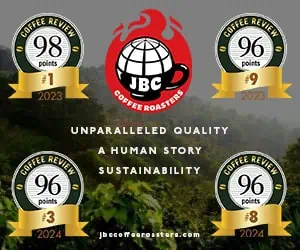As we sweat our way into summer 2018, enjoying coffee chilled on ice is peaking as the latest specialty coffee trend. Espresso, of course, has long appeared in various cold-blended café concoctions like frappés and smoothies, as well as in bottled ready-to-drink (RTD) beverages heavy on sweetener, milk and flavorings.
But this latest cold coffee trend differs from those earlier products by attempting to offer a cold or iced version of a fine, specialty black coffee experience. (And, in some cases, a gently fizzy version of that experience achieved through infusing the black coffee with nitrogen.)
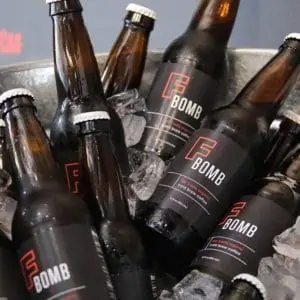
Roast House’s F-Bomb Cold-Brew Coffee. Courtesy of Roast House.
Cold-brewed coffee is nothing new, of course. Brewing coffee by allowing the ground coffee to sit for a prolonged time in cold or unheated water has been plausibly traced back to at least the 1600s in Japan. Nor is there anything new about serving black coffee over ice. What is new in North America is the current emphasis on these practices and the general fuss over them. Specialty coffee companies small and large are intensely at work trying to bring some of the sensory refinement and differentiation available in whole-bean coffee to the arena of ready-to-drink cold black coffee in cans and bottles. Cold coffee helps keep their businesses moving through the hot-beverage doldrums of summer.
24 Canned or Bottled Black Coffees
To test the success of this effort, we sampled 24 black coffees sold in single-serve cans or bottles. All were pure brewed black coffees, with no additives aside from the transitory presence of nitrogen gas infused into those coffees offered in “nitro” versions and, in one case, a tiny amount of vitamin C added as preservative.
As usual, we tested these coffees blind, identified only by number. Our rating system requires five categories to generate a score, so in place of the usual aroma category, which is difficult to apply to pre-brewed coffee served over ice, we added a “with milk” category, giving us the following five categories: structure/acidity, body, flavor, aftertaste, and character when tasted with milk.
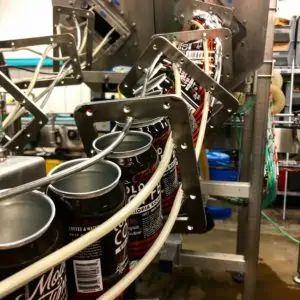
The canning line for cold brew at Modern Times Coffee. Courtesy of Modern Times Coffee.
Our protocol was simple: We measured out 95 grams/milliliters of each chilled black coffee, combined it with 45 grams of ice, and did our best to taste it immediately, before the ice had much opportunity to melt. We then conducted a second round of tasting in which we added 10 grams/milliliters of cold whole milk to the same weight/volume of coffee and ice
Cold Coffee Scorecard
So, is it possible for a lover of fine specialty coffee to simply grab a can or bottle out of the cooler and enjoy a chilled, refreshing equivalent of the refined experience we expect when we enjoy a freshly brewed cup of our favorite specialty coffee?
Based on the very best of these 24 coffees, the answer is yes, so long as one accepts certain limitations with regard to choice and availability (read on). The 24 RTD cold black coffees we tested averaged a rating of 89, extending from a low of 75 to a high of 94. The 11 top-rated samples are reviewed here at scores of 90 to 94.
Cold Coffee Thoughts and Issues
Brewing Method. All but one of the canned and bottled coffees we review this month were cold-brewed (rather than hot-brewed and subsequently chilled). Some were brewed as a concentrate, filtered and diluted; others were simply cold-brewed, filtered, and canned or bottled.
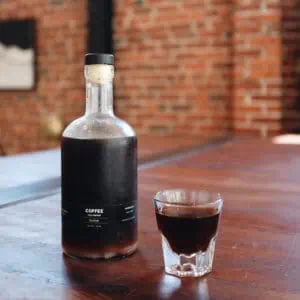
States Coffee & Mercantile’s Reserve Cold Brew made with coffee from Tanzania. Courtesy of States Coffee.
Cold Brew Character. Cold brewing generally produces a somewhat different beverage than hot brewing does. The long, slow extraction tends to encourage a cup that is delicate and lightly syrupy in mouthfeel with a softer structure than produced by conventional hot brewing. Both acidity and bitterness tend to be muted. Flavor notes may be subtler in impact and often influenced by a caramelly sweetness. The Peet’s Baridi Black Cold Brew, for example, a dark-roasted coffee that, when brewed hot, tends to be bitter in structure, seemed quieted and rounded in its cold-brewed incarnation. We review it here at 92. On the other hand, we rated another dark-roasted, cold-brewed coffee at 75. Its empty, sodden, burned-building char seemed, if anything, intensified by the cold-brew method. So cold brewing clearly is not a panacea for poorly sourced or roasted coffee!
“Low Acidity” and Cold-Brewed Coffee. Cold-brewing in general tends to round and soften acidity, the bright, sweet-tart sensation that is admired by many coffee lovers, but avoided by others, who associate it with sour stomach and other symptoms of indigestion. Consequently, manufacturers and vendors of cold-brew devices have made “low acidity” a key element in their marketing. The cold-brewer manufacturer Toddy, for example, prominently boasts that coffee cold-brewed using their device is “approximately 67% less acidic than coffee brewed by conventional hot-brew methods.” Although no study that I could find, apart from a single piece of perfunctory lab work commissioned by Toddy itself, supports that statistic, cold-brewed coffee certainly tastes less intense all around, and part of that attenuated intensity usually includes a softened, more delicate acid sensation.
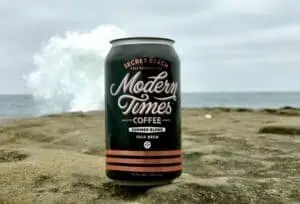
Modern Times Black House Blend Cold Brew. Courtesy of Modern Times Coffee.
Mainly Blends, but Good Ones. Most of the samples we tested were blends. Nevertheless, the best of these blends were quite distinctive in character. For example, the 93-rated Modern Times Black House Blend Cold Brew was a delicately bright, engagingly intricate blend of a dried-in-the-fruit “natural”-processed Ethiopia and a traditional Sumatra, an updating of the ancient Mocha-Java blend.
But Bad News for Coffee Farmers?
Generally, however, the specific identity of the green coffees that contributed character and quality to the beverages in the cans or bottles we tested was backgrounded. Way backgrounded. Even when a coffee consisted of a single origin, that origin was either not mentioned on the can or bottle, or noted only generally, as with Cadence Cold Brew’s 93-rated, refreshing and lively Single Origin Ethiopia.
This trend may be bad news for coffee producers. Recall that in the world of fine whole-bean coffee, farms and cooperatives are typically named and celebrated on roaster websites and coffee bags. This practice has enabled many producers to establish robust, essentially branded reputations and attract significantly higher prices for their coffees.
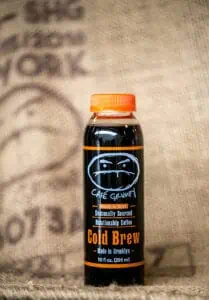
Cafe Grumpy’s Cold Brew. Courtesy of Cafe Grumpy.
It would seem, however, that in the current world of cold brew, as in the world of espresso, the role and identity of the green coffee producer is close to invisible. Perhaps this is because relabeling cans and bottles to reflect seasonal changes in coffee sourcing is more cumbersome and expensive than relabeling bags. Or perhaps it is because the implicit analogy for upmarket whole-bean coffee is wine, with its celebration of farms and regions, whereas the implicit analogy for cold-brew coffee appears to be beer, where the agricultural source of key ingredients tends to be backgrounded or generalized.
Finding the Best Ready-to-Drink Black Coffees
Back to Brick and Mortar? Paradoxically, the new trend toward cold coffee may be pointing specialty coffee back towards its local roots, to the days when the most dependable way to get a genuinely fresh whole-bean coffee was to mosey down to the people who roasted it and get it scooped out of a bin and handed to you. Shipping cans or bottles of brewed coffee through the mail is expensive and cumbersome, complicating Internet sales and encouraging direct local sales through specialty food stores and the like.
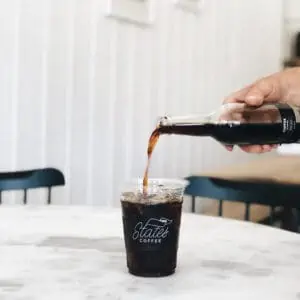
States Coffee & Mercantile’s Cold Brew. Courtesy of States Coffee.
You may be able to purchase some of the refreshing, lively summer coffee experiences we review here online, but your local specialty food market may also be an option. Whole Foods Markets, in particular, often carry an assortment of local and nationally branded cold-brew coffees.
But you also may want to investigate your own cold-brew scene. Perhaps there is a tiny roaster near you like States Coffee, a one-store location in the charming town of Martinez, California, where Keith Gehrke leads a team that hand cold-brewed, filtered and bottled two of the fine cold coffees reviewed here. The richly sweet yet zesty States Coffee Reserve Cold Brew topped this month’s ratings at 94, while the complex and eccentric States Cold Brew, with its hints of tequila-barrel ferment, came in at 93.
Or you may find a locally prominent roaster in your city, like Spokane’s organic/fair-trade focused Roast House, whose fruit-forward, chocolaty F-Bomb cold brew rated 93. Or Brooklyn’s Café Grumpy, with its crisply citrusy and cocoa-toned Cold Brew (92), or Silicon Valley’s Barefoot Coffee Roasters, with its brisk yet sweetly caramelly Cold Brew (91). Perhaps you may find an equivalent for our Oakland neighbor Black Medicine, a roaster/bottler that only produces bottled cold coffee that has been brewed hot under pressurized nitrogen before cooling, diluting and bottling. Black Medicine’s crisp, vibrantly sweet-tart Cold-Pressed Coffee is reviewed here at 91. Cadence Cold Brew, based in Madison, Wisconsin, distributes its line of lightly nitrogen-infused cold brews in specialty food stores throughout the upper Middle West. We review its lively, gently bright, quietly intricate Single Origin Ethiopia at 93.
San Diego’s Modern Times is perhaps unique in its exuberant commitment to both brewing exceptional beer and roasting distinctive coffees. The overlap encourages an always- interesting line of cold-brew coffees. We review two Modern Times coffees here: the briskly vivacious and fragrantly berry- and floral-toned Black House Blend Cold Brew at 93, and the bright, bracing Secret Beach Summer Blend at 90.
The Nationally Distributed Options. We did test three ready-to-drink black coffees with national or close-to-national distribution. Blue Bottle’s Cold Brew (we found it at our local Whole Foods Market) is reviewed here at 93 for its balanced, classic profile in cold-brew format. Peet’s Coffee & Tea’s dark-roasted Baridi all-Africa blend (92) surprised us with both the depth and balance of its savory-sweet structure. Starbucks’ rather scorchy, dry, though cocoa-toned Cold Brew Black, not reviewed here, attracted a rating of 87.
Nitro Brew
Nitro in Cans. Infusion with nitrogen gas adds a delicate, very fine-bubbled, often velvety texture to many canned cold-brewed coffees. (This is not the large-bubbled, fizzy impact gotten with CO2.) Generally, when we had an opportunity to sample both still and nitrogen-infused versions of the same coffee, we found the nitrogen infusion enlivened mouthfeel, while arguably slightly blurring or muting flavor notes.
Creamy Kegged Nitro Brews. Cafés often serve a nitrogenated cold coffee from kegs that offers a visual spectacle similar to Guinness stout. The coffee cascades creamily from the tap, and holds a velvety head for some time after dispensing. You will not experience this striking effect from any of the canned nitro coffees reviewed here, however. What you will get is a light, rather evanescent layer of froth and a more buoyant, possibly plusher mouthfeel than you may from a non-nitrogenated version of the same coffee.
To achieve the Guinness effect in a canned beverage, a device called a nitrogen widget (!) is necessary. A widget (Guinness uses a widget in its canned stout) is a small hollow plastic reservoir that stores some of the nitrogen gas infused into the beverage. When one opens the can, the nitrogen gas stored in the widget disperses in the beverage, promoting a creamy mouthfeel and impressive, lasting head of fine-textured froth.
We tested only one nitro coffee using a widget. The good news is, the widget worked. The pour from the can was velvety, and the head atop the (very dark-roasted) coffee was attractive and contrasty. The bad news: the coffee was overroasted, charred and rubbery.
Back to the Best, and Thanks
But the best of these ready-to-drink black coffees, including those reviewed here, were impressive in their fusion of crisp, summery refreshment and distinctive, genuinely fine-coffee-specific character and expressiveness.
Thanks to all who sent us coffees, and particularly to those roasters who shared their passion and knowledge regarding fine cold-brew production: Keith Gehrke of States Coffee & Mercantile; Aaron Jordan of Roast House Coffee; Caroline Bell of Café Grumpy; and Bartleby Bloss of Modern Times. Good words, good coffees.





